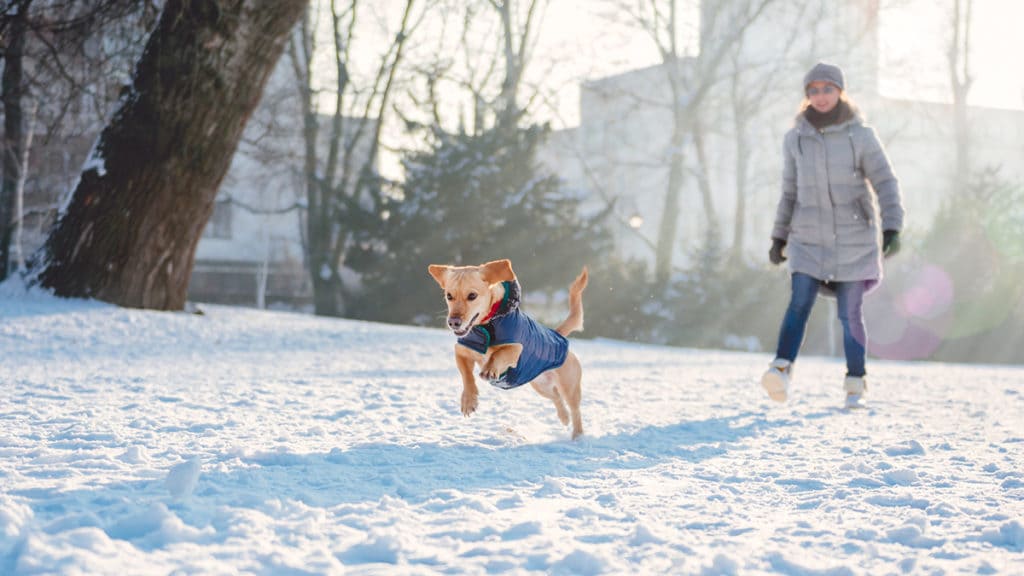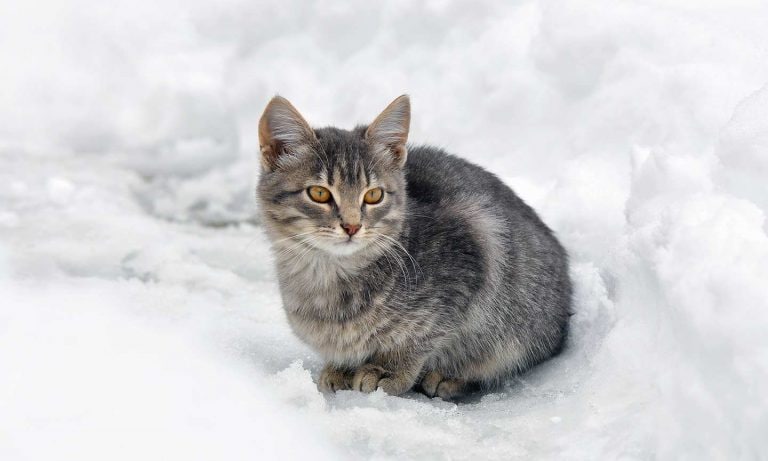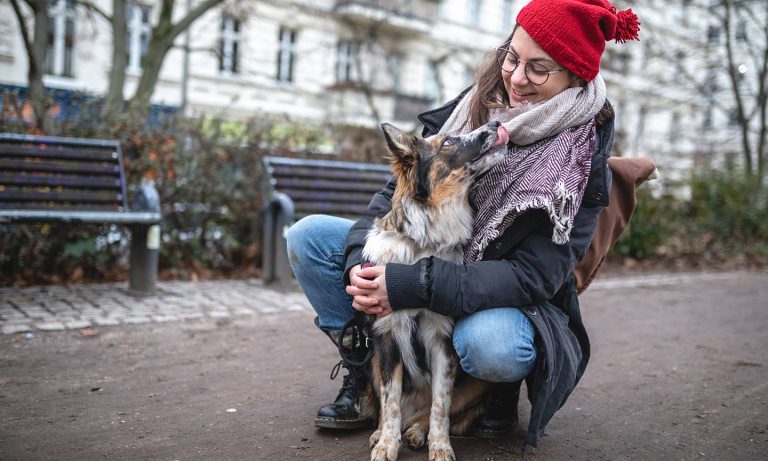When it’s beginning to look a lot like winter, that’s the perfect time to prepare our homes and our furry family members for the colder weather and all that comes with it. Just like us, cats and dogs get cold when the temperature drops, and they might experience increased discomfort with current ailments or become more susceptible to illness. But here’s the good news: There are plenty of steps you can take to minimize discomfort for pets.
Top Cold-Weather Concerns For Pets

Via iStock.com/Pekic
Most of our dogs and cats are covered with fur, and some breeds seem to tolerate the cold more naturally. But “every breed has different limits of hot and cold, and each pet should be considered individually,” says Dr. Sara Witherell, a board-certified associate veterinarian at Animal Kind Veterinary Hospital in Brooklyn, New York.
Some factors that affect an individual pet’s tolerance for cold temperatures are:
- Their coat
- Age
- Body fat
- Activity level
- Overall health
The very young and old, small pets, short-haired and hairless varieties, those with chronic disease (including heart disease, Cushing’s disease, arthritis and kidney disease), and pets with special needs also are less cold-tolerant and more likely to experience problems.
Here are some important cold-weather concerns to especially watch out for:
1. Hypothermia (lowered core body temperature)
Hypothermia can happen when pets are exposed to extreme cold for an extended period of time if their fur and skin remain wet in the cold. Signs to look for are paleness, shivering and lethargy. In more extreme cases, the shivering stops and the lethargic pet progresses into a comatose state. Scary!
Consult your veterinarian immediately if you suspect your pet is experiencing hypothermia. If that is impossible, veterinarians recommend slowly rewarming the chilled pet by wrapping him in warm blankets, placing a hot water bottle wrapped in a towel against his abdomen to keep his core (and those vital organs inside) warming up to a normal temperature range of 100 to 102.5 degrees Fahrenheit, and giving conscious pets warm (not hot!) water to help warm up from the inside out.
2. Frostbite
Frostbite freezes and kills the skin cells. It most commonly affects the paws, nose, ear tips and tail of dogs and cats after exposure to extreme cold conditions. The skin often appears pale, bluish-white or gray and feels significantly colder and firmer than surrounding skin to the touch.
Again, immediate veterinary care is needed, if possible. In the meantime, experts say owners can warm the frostbitten areas by wrapping them in warm, moist towels, changing them frequently to keep them warm, or submerging those areas in warm water. You need to be sure the temperature of the towels or water is warm, not hot, to avoid burning your dog or cat. Also, resist the urge to rub the frostbitten area, because this will cause damage. As circulation returns to the area, you will see the skin redden.
3. Toxicity
Secondary to the cold weather, veterinarians warn that poisoning or toxicity issues are common this time of year. Dr. Witherell says they frequently see irritation to the skin between the footpads due to salt and ice-melt products, and Dr. Gary Thompson, a board-certified veterinarian at West Suburban Animal Hospital in Toledo, Ohio, says poisoning, especially from antifreeze toxicity, is the biggest heath risk this time of year, after the cold weather.
“It only takes a few drops [of antifreeze] to kill a small dog or cat,” he says, “so people need to be very mindful of any leaks or spills when they add antifreeze to their cars.”
Because of its sweet taste, antifreeze actually can attract pets as well as children, so it’s important that owners keep these and all household chemicals out of their reach. Dr. Witherell adds that dogs and cats might be exposed to antifreeze by stepping in it and licking paws or drinking from puddles, so be vigilant about cleaning up even the tiniest of spills or leaks.
Dr. Witherell says that putting plastic booties or shoes on a pet protects them from salted walkways or antifreeze, while carrying a towel to wipe their feet as needed and rinsing them when you return home helps minimize the poisoning or toxicity from salt or antifreeze residue.
And while we’re talking about poisoning, be sure your dog or cat cannot access medication bottles, household chemicals and potentially toxic foods, such as onions, xylitol (a sugar substitute increasingly found in foods as well as gum and toothpaste), garlic, macadamia nuts and chocolate.
At What Temperature Should You Bring Your Pet Inside?

Via iStock.com/Alikaj2582
So how do we know when it’s too cold for our pets to be outdoors?
“Generally, if we are cold in our winter wear, it is too cold for most pets to be outdoors for more than a few minutes,” Dr. Witherell says, adding that “Dogs with thicker coats, such as Huskies, can tolerate temperatures a bit lower, but generally below 35 degrees Fahrenheit, people should limit time outside for most pets…[and] when it is below freezing—32 degrees Fahrenheit—most pets would be better off indoors.”
Keeping Pets Warm During Walks And Play
For those of us with indoor-only pets, or those we bring inside during the cold weather, there are easy ways to keep them warm and safe during outdoor potty breaks and exercise time.
“Insulated coats and water resistant booties/shoes can help to minimize discomfort,” Dr. Witherell says, adding that she recommends shorter walks and cutting playtime on days that are uncomfortably cold to be outside.
Winter clothes designed for dogs and cats can go a long way to keep them warm when we take them out for a walk or for some exercise.
“It is fine to leave a sweater or coat on small/shorthaired animals indoors,” Dr. Witherell says, “especially during times the thermostat is turned down, such as while the owner is at work or overnight.”
So keep dog winter clothes in mind, especially for small or toy dogs and those with short hair, such as Chihuahua dogs, Italian Greyhound dogs and Sphynx cats, as well as frail or ill dogs or cats.
And while we want to keep our pets inside more during the cold weather, it’s important to take dogs out for elimination frequently enough to prevent health issues. Dr. Thompson says he sees more bladder infections when the weather gets cold because dogs are not getting out to go to the bathroom as often as they should.
Safe Indoor Heat Sources For Pets
Other ways to warm up indoor dogs and cats include electric heating pads, heated dog beds, portable heaters, fires and hot water bottles. However, veterinarians warn against allowing pets, especially those with short coats, to have direct contact with portable heaters, fires and electric heating pads, because of the risk of burn injury.
“Passive heat is the best option,” Dr. Thompson says. “Many types of pads pose a burning risk, and anything that could be a fire hazard should be avoided.”
Because animals tend to hide out in warm areas, remember to check your car or clothes dryer before use. Clever pets might find those warm clothes inside the dryer or the warmth inside or under a car to be an ideal place for a snooze.
When trying to keep warm, guard against accidentally overheating your indoor pet. For example, Dr. Witherell says that if the temperature gets above 75 degrees Fahrenheit, which may sound nice and toasty to you, brachycephalic dogs (think Pugs and French Bulldogs) and cats (such as Persians) are at risk of overheating.
Winter is also a good time to check the places where your indoor dogs and cats sleep. Are they sleeping on tile, stone or wood floors instead of carpeting? Pet beds, rugs, cushioned mats and blankets will make dogs and cats more comfortable and help them stay warm. Is the bed on the ground somewhere with drafts? If so, raise the bed a few inches off the ground. Arthritic and older dogs and cats can benefit from a wrapped hot water bottle or pet-safe heated bed and extra blankets to help keep them from getting stiff in the colder weather.
Grooming Helps Pets Stay Warm

Via iStock.com/sestovic
Believe it or not, grooming comes into play to help our dogs and cats stay safe, warm and healthy in the cold weather. Both Dr. Thompson and Dr. Witherell say to avoid shaving thicker-coated breeds because keeping a thicker/longer coat on dogs in the winter can help keep them warmer on cold days. Dr. Witherell adds that keeping hair on the feet longer can help minimize irritation from salt on sidewalks.
Dog owners still need to bathe their dogs during winter to keep dog odor at bay. Bathe your dog indoors during the winter and take extra care that your pet is completely dry before letting them go outside so they do not get chilled. Regular brushing and combing keeps mats and knots from becoming major issues, and lets you discover any hidden lumps, bumps or sores a pet’s winter coat might be hiding.
Also, when dogs come in from outside, watch for snow or mud balls that might have accumulated between the pads and check their pads for cracks and cuts.
Keeping Outdoor Pets Warm
Ideally, keep dogs and cats indoors. However, if your pet spends much of their days outside, provide dry, draft-free shelter protection that is large enough for them to comfortably sit up and lie down in, and small enough to hold in their body heat. Even dogs, such as Alaskan Malamutes and Chow Chows, that adapt quite well to the cold need warmth and shelter outdoors.
Outdoor dogs and cats also need a bed or sleeping spot raised a few inches off the ground and covered with wood shavings, straw or blankets to keep them warm. Remember to regularly clean and change the bedding to make sure it’s not damp, germy or filled with fleas. Covering the shelter doorway with heavy plastic or waterproof burlap will help keep cold winds out and body heat in.
When living in Georgia, we cared for several feral neighborhood cats. During the cold temperatures and weather, we put out a heated bowl designed for outdoor use to make sure the cats had constant access to clean and unfrozen water. We also left the garage door raised just enough for the cats to squeeze under so they had a safe and warm shelter when needed.
This setup also ensured the cats had fresh, unfrozen water and extra nutrition, which they need to replenish the extra energy expended to keep warm. Often we would find a cat resting atop the car enjoying the warmth the engine heat provided.
Car engine warmth brings up an important point. Small animals, including cats, often are attracted to the warm engines of recently driven, parked cars. They’ll even crawl up under the hood to snuggle in the warmth. This makes it exceedingly important to honk and/or knock on the car hood to scare them away before starting the engine.
Also, watch for slippery surfaces like a patch of ice, as Dr. Thompson says that slips and falls can lead to ligament injuries, and Dr. Witherell says that pets with arthritis are at higher risk of slip and fall injuries in cold or icy weather. Use traction booties and slings to limit this risk. There is a lot we can do to easily create a safe, warm and cozy winter season for our dogs and cats. I hope these tips help you.
Want to know more about cold weather safety? Check out:
- Solutions for Caring for Cracked Pet Paws
- Dog Safety Tips for Blizzards Every Pet Parent Should Know
- 9 Winter Hacks to Make Your Dog’s Life Easier
Share:









